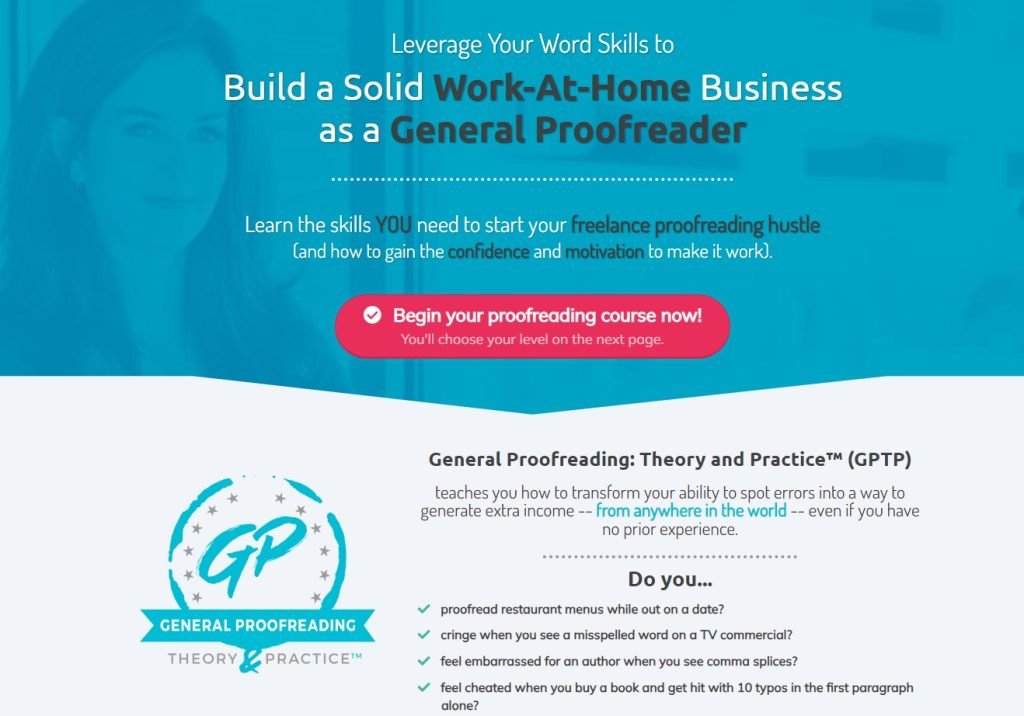Proofreading might look easy from the outside, just spotting a few typos and grammar mistakes, right? But anyone who’s done it knows it’s much more than that. It requires intense focus, strong language skills, and an almost obsessive attention to detail. It also takes time to train your eye to catch the kinds of errors most people miss.
When I began working as a freelance proofreader, I quickly realized that learning grammar rules was just the beginning. The real skill came from hands-on experience, trial, error, and building systems that helped me spot mistakes faster and with more confidence. Over time, I picked up practical habits that made proofreading smoother, more accurate, and far less overwhelming.
In this article, Training to Be A Proofreader I’m sharing the tips I’ve learned through my journey. These aren’t textbook tricks; they’re real lessons I’ve picked up from working with clients, meeting deadlines, and improving my process every step of the way. Whether you’re just starting or looking to sharpen your skills, I hope these insights will make your path into proofreading a little easier and a lot more effective.
What is Proofreading?
Proofreading is the final step in the writing process, where you check for grammar, punctuation, spelling, and formatting errors. It’s about polishing content before it goes live or to print. A proofreader’s job is not to rewrite or reword, it’s to catch mistakes.
9 Best Courses For Those Training To Be A Proofreader

If you’re serious about becoming a professional proofreader, enrolling in a course can fast-track your learning. I’ve tested and researched dozens of programs, and here are the 9 best proofreading courses—each with its unique strengths. Whether you’re a complete beginner or looking to refine your skills, there’s something for everyone here.
1. Proofread Anywhere – General Proofreading: Theory and Practice
Best For: Serious beginners who want a comprehensive path to freelancing.
This course by Caitlin Pyle is one of the most popular and trusted proofreading programs. It covers everything from grammar rules to working with clients and even marketing your services. The modules include real-world examples, quizzes, and practice files.
What I Loved:
You get a step-by-step roadmap and access to a private Facebook group of active proofreaders. It also includes a graded exam for certification.
Bonus: You also get business setup guidance—a big help when you’re just starting out.
Cost: Around $497 (payment plans available)

2. Knowadays (formerly Proofreading Academy) – Becoming A Proofreader
Best For: Those looking for a globally recognized certificate and remote work opportunities.
Knowadays offers in-depth training and a final assessment. If you pass, you can start working with their partner company, Proofed, as a remote proofreader. This course focuses heavily on British and American English differences, formatting, and academic writing.
What I Loved:
The clean, intuitive course interface and clear learning path. The opportunity to start working right after certification is a huge bonus.
Cost: $399 (often discounted)

3. Udemy – Proofreading Power: Become an Effective Proofreader
Best For: Budget-conscious learners who want quick, practical lessons.
Taught by Ashan Hampton, this course is great if you’re new to proofreading and want to dip your toes in. It includes grammar refreshers, punctuation rules, and proofing strategies.
What I Loved:
It’s affordable, has lifetime access, and comes with downloadable resources.
Cost: $20–$30 (often discounted during Udemy sales)
4. Coursera – Grammar and Punctuation by University of California, Irvine
Best For: Those who need to improve grammar before diving into proofreading.
This course is part of the Academic English Specialization and is perfect if your grammar foundation is shaky. You’ll learn basic punctuation rules, sentence structure, and grammar usage—all crucial for proofreading.
What I Loved:
University-backed structure and peer-reviewed assignments. Great as a foundational course before specialized proofreading training.
Cost: Free to audit; $49/month for certificate
5. Edit Republic – Freelance Proofreader Course
Best For: Beginners who also want insight into freelance editing and running a business.
Formerly called the Ink Well Guild, this course by Phon Baillie is practical, straight-to-the-point, and designed specifically for people who want to freelance. You’ll learn proofreading rules, how to set up your business, and client acquisition strategies.
What I Loved:
It feels very human, relatable, and confidence-boosting for total beginners.
Cost: $497
6. Publishing Training Centre (UK) – Essential Proofreading
Best For: Those who want a formal qualification and work in publishing or traditional media.
This is a highly professional and intensive proofreading course based in the UK. You get assignments graded by tutors and complete the program over several months. It’s ideal for people seeking employment or agency work.
What I Loved:
Rigorous feedback and recognition in the UK publishing industry.
Cost: Approx £395 (GBP)
7. The Chartered Institute of Editing and Proofreading (CIEP)
Best For: Those who want to develop their skills systematically over time.
CIEP is a respected professional body for editors and proofreaders. Their introductory course is great for structured learners. It teaches terminology, markup symbols, and working with clients in both print and digital formats.
What I Loved:
You learn professional proofreading marks and get a solid understanding of industry standards.
Cost: £99–£165 depending on membership status
8. Skillshare – Proofreading Your Writing
Best For: Casual learners or writers wanting to improve their own writing.
Skillshare offers several proofreading mini-courses, and this one by Erin Rickard is ideal for creatives or content writers who want to self-edit. It’s bite-sized and visually engaging, with real-time examples.
What I Loved:
Quick, easy lessons with real examples. Great to brush up on specific skills.
Cost: Free with Skillshare trial or subscription (approx. $15/month)
9. The Writer’s Workshop – Proofreading and Copy-Editing Course (UK)

Best For: Aspiring proofreaders who want one-on-one feedback.
This UK-based course offers personalized tutor feedback, real manuscript samples, and flexible study schedules. It focuses on both proofreading and light copy-editing, making it perfect for multi-skilled freelancers.
What I Loved:
The one-on-one attention and practical assessments help boost your confidence.
Cost: Approx £495
Some Proofreading Tips From Personal Experience!
When I first started proofreading, I thought it was all about knowing grammar rules. But I quickly learned it’s also about consistency, patience, and having the right mindset. Below are some of the most valuable proofreading tips I’ve learned from personal experience—tips that helped me go from second-guessing everything to confidently delivering clean, polished work.
1. Slow Down—Seriously
When I was starting out, I used to rush through documents to prove how “efficient” I was. That led to missed errors and sloppy work. Proofreading isn’t a race. You need to give your brain time to absorb what’s on the page.
Tip: Read slowly, and if the document is important or long, take regular breaks. A fresh mind always catches more errors than a tired one.
2. Read It Aloud
This was a game-changer for me. Reading out loud helps you catch awkward phrasing, repeated words, and grammar mistakes that your brain might automatically correct when reading silently.
Example:
In your head, you might skim over “She went to the store.”
Read it aloud, and you’ll instantly hear the mistake.
Tip: If you can’t read aloud, try whispering or using text-to-speech software.
3. Print It Out (If You Can)
There’s something about looking at a physical page that helps you catch errors you might miss on screen. When I printed out documents and used a red pen, I found more issues, especially with punctuation and spacing.
Tip: Use this technique for important projects like résumés, books, or final drafts.
4. Focus on One Type of Error at a Time
Trying to catch spelling, grammar, punctuation, formatting, and consistency issues all at once is overwhelming. I learned to do multiple passes, each with a focus.
- First pass: Grammar and spelling
- Second pass: Punctuation
- Third pass: Formatting and layout
- Final pass: Read for flow and clarity
Tip: Slowing down and focusing on just one category of error per pass will make your proofreading more effective and less stressful.
5. Use the “Backward Reading” Technique
This one sounds odd, but works. Reading a document backwards—sentence by sentence or even word by word forces you to focus on each word in isolation. It removes context, which is exactly what your brain relies on to “autocorrect” mistakes.
Tip: This method is especially useful when proofreading short texts like headlines, ads, social media posts, or résumés.
6. Keep a Personal “Error Log”
I noticed I kept making the same mistakes—like confusing affect/effect or forgetting Oxford commas. So I started keeping an “error log” where I wrote down mistakes I missed or things I wasn’t 100% sure about.
Tip: After every project, jot down the types of errors you missed or struggled with. Review this list before your next project—it’s your personalized study guide.
7. Use Tools, But Don’t Rely on Them
Yes, tools like Grammarly, Hemingway, and PerfectIt can be lifesavers. But they’re not perfect. Sometimes they miss obvious mistakes, and sometimes they flag correct things.
Tip: Use grammar checkers as a first-pass safety net, but always do a final manual review. Trust your eyes, not just the software.
8. Pay Extra Attention to Names, Numbers, and Titles
You’d be surprised how often people misspell names, reverse numbers, or mislabel titles. I once approved a document where a CEO’s name was spelled incorrectly, and the client wasn’t happy.
Tip: Always double-check proper nouns, figures, email addresses, dates, and headers. These are small details, but they carry big consequences.
9. Know When to Stop
There’s a point where you’re no longer finding real errors, just nitpicking. I used to waste hours trying to make every sentence “perfect.” Over-editing can actually introduce new mistakes or strip the writer’s voice.
Tip: Do a maximum of 2–3 focused proofreading passes. Then let it go. Perfection isn’t the goal—clarity and correctness are.
10. Build a Checklist for Repetitive Tasks
If you’re proofreading the same type of document frequently (like blog posts, newsletters, or academic papers), build a checklist of common things to review. Mine includes:
- Are all headings styled consistently?
- Are all hyperlinks working?
- Is the tone consistent throughout?
- Did I check for extra spaces or double periods?
Tip: Having a checklist keeps you consistent and speeds up your workflow.
11. Take Breaks Between Edits
Your brain stops noticing mistakes when it’s tired. I learned that when I tried to proofread a 10,000-word document in one sitting. Spoiler: it didn’t go well.
Tip: For long texts, break the task into sessions. Even a 10-minute break can reset your focus and help you catch more in your next pass.
12. Zoom In and Zoom Out
Sometimes formatting errors or spacing issues are hard to catch when you’re zoomed out. Other times, big-picture issues are missed when you’re too close to the text.
Tip: Use both views. Zoom in (like 150–200%) to catch extra spaces, misaligned text, or punctuation errors. Then zoom out (75–100%) to see the overall structure.
13. Don’t Proofread When You’re Tired or Distracted
I’ve tried proofreading at the end of long days, during noisy family dinners, or with a Netflix show playing in the background. Bad idea every time.
Tip: Choose a quiet, well-lit space when your brain is sharpest—usually in the morning. Even 30 minutes of focused work beats hours of distracted reviewing.
14. Stay Curious About Language
The more I read, the better my proofreading becomes. I follow grammar blogs, read style guides, and pay attention to how language is used in different formats. Curiosity sharpens your instincts.
Tip: Subscribe to newsletters like Grammar Girl or the Chicago Manual of Style’s Q&A blog. They’re short, fun, and informative.
15. Be Kind To Yourself
When you miss a typo even after triple-checking it-it’s easy to feel like a failure. But even professional editors with years of experience miss things. That’s why teams often include multiple proofreaders.
Tip: Learn from your mistakes and move forward. You’re improving with every project. Perfection is impossible—progress is what matters.
How Much Can I Earn From Proofreading?
How much you can earn from proofreading depends on your experience, niche, and the type of clients you work with. Beginners typically earn between $15 to $25 per hour, while more experienced proofreaders can charge $30 to $50+ per hour or $0.02 to $0.05 per word. Specialized fields like legal or academic proofreading often pay higher. As a freelancer, your income can grow steadily as you build your portfolio and client base.
FAQs About Training To Be A Proofreader
Do I need a degree to become a proofreader?
No. Training, practice, and a strong portfolio matter more than formal education.
How long does it take to become a proofreader?
With daily practice, you can start taking small jobs within 2–3 months.
How much can a freelance proofreader earn?
Beginners earn $15–$25/hour. Experienced proofreaders charge $40/hour or more.
What’s the best course for proofreading?
Proofread Anywhere is the most in-depth. For cheaper options, Udemy and Coursera are great.
Is AI replacing proofreaders?
AI tools are helpful, but human proofreaders are still essential for quality and nuance.
Hi there. My name is Abbas Khan. I’m passionate about finding smart ways to save and make money from anywhere in the world.
Learning how to earn remotely and manage my finances gave me true freedom, and now I want to help you do the same.
Join me as I explore money-saving hacks, income ideas, and tips to build a flexible, location-independent lifestyle you’ll love.

